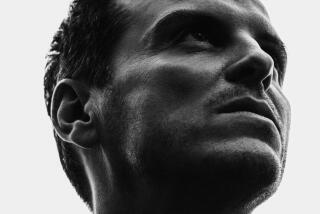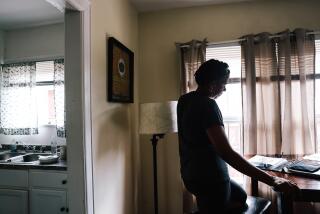Addiction Lifted, but at a Price
Lavelle Scott literally got the crack knocked out of him. But exactly what happened on that November day in 1990 may never be told. Scott simply doesn’t remember.
He landed in intensive care at County-USC Medical Center, slipping in and out of consciousness, suffering from a severe head blow that caused permanent damage.
When he finally came to weeks later, his cravings for crack cocaine had vanished. But so had a significant chunk of his memory from the 1980s, when he and thousands of others in Los Angeles were swept up in the crack epidemic.
“It’s a miracle,” said his mother, Patricia Scott. “I don’t think Lavelle would be alive today had that terrible thing not happened. He was a crackhead, a hard-core drug addict. It saved his life.”
It’s a measure of the devastation of crack cocaine--to a community and one man’s life--that Scott and his family view his violent cure as a gift, despite the severe limits it has imposed on his life.
The injury left him unable to function on his own. But it has restored serenity to his life and modest pleasures. Now Scott can bask in the company of his 12-year-old son, feel the love of a mother who stood by him. Together, they resurrected a life with music that drugs had all but killed.
It is, however, a mixed blessing.
“It’s like you have a violent husband who is self-destructive, but then he gets Alzheimer’s and calms down,” his mother said.
Neurologist Bruce J. Weimer, who treated Lavelle Scott from 1992 to 1997, said the head injuries “edited out” portions of his past.
“He lost a good part of his life that he simply can’t ever recall,” Weimer said. “It turned out not to be a very good period of life for him, a period of time [when] he was addicted to crack.”
Scott suffers from short-term memory loss, which means his brain has difficulty encoding new information. For example, Weimer said, Scott can remember events from his childhood, but he has trouble recalling what he had for lunch.
It’s the same condition dramatized in “Memento,” a film that portrays a brain-injured man’s use of Polaroid pictures, scribbled notes and his own body tattoos to overcome memory loss and find his wife’s killers.
Susan Bookheimer, an associate professor at UCLA’s Brain Mapping Center, said it is quite unusual to find an addiction cured by the loss of short-term memory. But in Scott’s case, she speculated, the injury may have blocked his ability to remember the environmental factors that trigger cravings--like a smoker losing the compulsion to light up after a full meal.
Doctors also say that Scott’s recovery from drugs may have been aided by the fact that his injury cut him off from the circle of friends who used the drug with him.
Little is known about what happened the night of Scott’s injury. He cannot recall who hit him or why. Back then, family members had grown accustomed to his disappearing for weeks at a time. They suspect he was living on the streets. They were not surprised that someone tried to kill him. Given that he was a crack addict, they expected it.
When Scott arrived at County-USC, doctors were pessimistic. They wondered whether he would ever walk again or be able to perform even such simple tasks as brushing his teeth.
After spending a month at County-USC, Scott was transferred to Rancho Los Amigos Medical Center, where he spent three months in a special unit for brain-injured patients.
Scott recalls none of his hospital experiences. His earliest memory begins after arriving back at home. The first months were fraught with problems as he struggled to make sense of a strange environment. He would call 911 dozens of times and say he was being held hostage. He would wander off and be picked up by police.
The job of caring for Scott fell on his mother, the same woman who put him out on the street when his addiction became intolerable.
During his recovery, Patricia Scott would rush to the hospital when he became disoriented and aggressive with the hospital staff. She brought him tapes of Bob Marley and Luther Vandross. At home, she papered the house with notes reminding him of mundane little things--where to go and what to do.
Making Sense of a Strange Environment
They spent hours playing the memory game Concentration, as well as gin rummy and other card games. She used flash cards and Scrabble tiles to stimulate his reading skills. She encouraged him to return to one of his former loves, the steel drums.
Today, Scott, 38, lives with his mother in a neat, wood-framed house in the Crenshaw district. He spends his days watching TV, playing computer games, doing chores and developing bonds with his son. He sometimes plays with his mother’s Caribbean music group, the Island Dreams Band.
He also lives with the consequences of his injuries and his past.
“It took away parts of my memory,” Lavelle Scott said. “I’ll do something like wash the dishes, clean the stove and defrost the refrigerator. And when my mother comes home, she’ll ask me, ‘What did you do today?’ and I’ll say, ‘I cleaned up the yard.’ The other things I did, but it just skipped my mind.”
A trip to the supermarket can be a serious challenge. Scott’s mother might return home to find five frozen pizzas crammed in the freezer, her son unable to recall what he bought on the last trip to the store.
Scott tries to compensate for his lapses by writing down and typing everything. He sometimes asks the same question over and over, as if trying to force-feed his brain information.
“I really try to work on my memory, try to make it kick back in,” he said.
There are constant reminders of how much his life has changed.
“I was walking and someone tried to sell me some drugs,” Scott recalled. “This guy kept saying: ‘Rocks! I got rocks!’ I told him to get away. I don’t ever want to use that stuff. It will make a monster out of you. It made a monster out of me, and I don’t ever want to be like that again.”
His mother spoke of her son’s frustration at living with a faulty memory, and how much we take memory for granted.
“There is what you look forward to and what you look back on, and there’s the moment--right now,” she said. “I can make plans and anticipate with great pleasure. He can’t do that. I can set goals and work toward it. He can’t retain it.
“What is left for him is to enjoy life when it happens. He lives in the moment.”
It wasn’t always like that.
Lavelle Scott learned to play steel drums in the early ‘80s from Carl McKnight, a Trinidadian who organized musicians in the Jefferson Park area.
The group became popular, playing their 55-gallon oil drums in the Rose Parade, at parties and county fairs. In the early ‘80s, Lavelle Scott, his mother, McKnight and the group cut an album. It was one of the first steel drum bands to include conventional instruments and vocals.
McKnight was shot to death in a neighborhood dispute in 1984, and the music group eventually disbanded. At the same time, the Jefferson Park area, like much of South Los Angeles, was in the middle of a cocaine epidemic that spawned crack houses, prostitution and violent crime.
In the Grip of Cocaine Epidemic
“There was a pawnshop down the street that was like a black hole, sucking up everything out of the neighborhood,” Patricia Scott recalled.
After McKnight’s death, Lavelle Scott continued to play the drums with some success. In 1989, he appeared on “The Gong Show” in a shirt he borrowed from a Jamaican drug dealer. He won first prize, $702 in cash.
“I spent the money on clothes and a lot of it on drugs, actually,” he recalled.
Scott’s life began to spiral out of control. He stole from family and friends to support his habit.
Then, in November 1990, the family received a telephone call, saying that Scott was clinging to life at the hospital.
“He was hooked up to all kinds of machines,” recalled his sister, Sabrina Scott. “There was something inserted in his brain to prevent swelling. He didn’t look good. He wasn’t responsive.”
Now, more than a decade later, Lavelle Scott has refashioned a life.
“The experts didn’t know what they were talking about,” said Patricia Scott of the many doctors who had predicted her son’s life had been damaged beyond hope.
“There’s only one expert, and he’s upstairs,” Lavelle said.
On a recent day, his son was visiting, watching his father take a turn on the steel drums.
“It’s a happy music, a party music,” Lavelle Jr. said.
“You have to be fast. . . ,” his father told him, offering a display of his skills. “It’s all in the touch, in the touch.”
Then, contemplating his life’s strange turn, Lavelle Scott had this thought:
“To all those people who thought I was gone . . . well, I’m back. That’s right, I’m back.”


